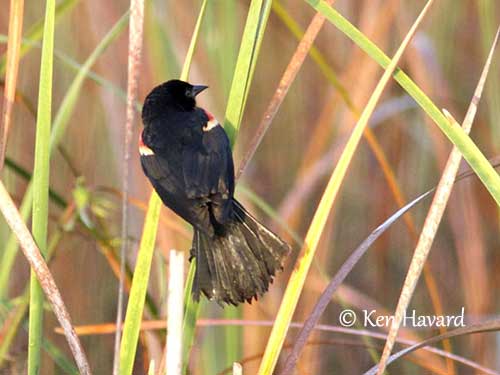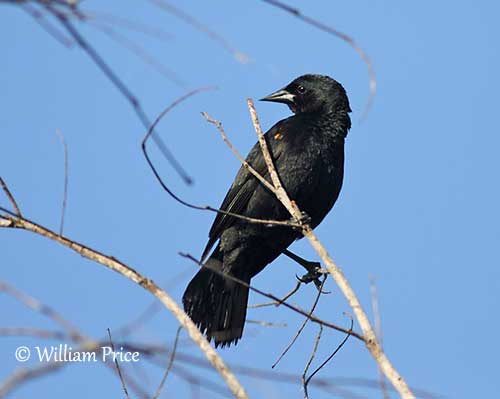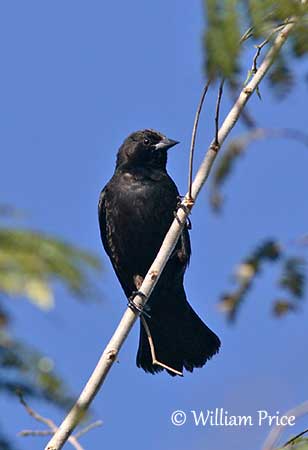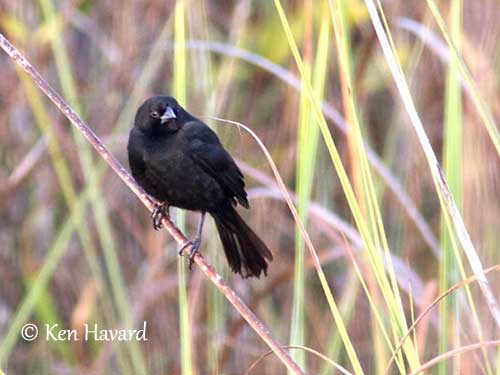
Fr: Carouge de Cuba
Ang: Red-shouldered Blackbird
All: Rotschulterstärling
Esp: Sargento Cubano
Ita: Ittero spallerosse
Nd: Roodschoudertroepiaal
Sd: zapatatrupial
Photographers:
Ken Havard
My Bird Gallery & Flickr gallery 1 & Flickr gallery 2
William Price
PBase-tereksandpiper & Flickr William Price
Text by Nicole Bouglouan
Sources:
HANDBOOK OF THE BIRDS OF THE WORLD Vol 16 by Josep del Hoyo- Andrew Elliot-David Christie – Lynx Edicions – ISBN: 9788496553781
NEW WORLD BLACKBIRDS – THE ICTERIDS by Alvaro Jaramillo and Peter Burke – Helm - ISBN: 0713643331
Neotropical Birds – Cornell Lab of Ornithology
The Context and Function of Duet and Solo Songs in the Red-Shouldered Blackbird
Red-shouldered Blackbird
Agelaius assimilis
Passeriformes Order – Icteridae Family
INTRODUCTION:
The Red-shouldered Blackbird is endemic to Cuba. It was formerly considered a subspecies of the Red-winged Blackbird (A. phoenicus), but several morphological and behavioural differences make them two separate species.
It is sedentary in Cuba and Isle of Pines, where it frequents wetlands for breeding and marshes outside the breeding season.
The Red-shouldered Blackbird locally common throughout its range and the population is currently stable and not globally threatened.
DESCRIPTION OF THE BIRD:
Biometrics:
Male:
Length: 22 cm – Weight: 54,5 g
Female:
Length: 20 cm – Weight: 42 g
The Red-shouldered Blackbird male has black plumage overall with slight bluish iridescence. It has a red epaulet formed by the red lesser upperwing-coverts, bordered by yellow-buff fringe formed by the median coverts.
The pointed, conical bill is black. The eyes are dark brown. Legs and feet are black.

The female has black plumage overall and lacks the coloured epaulets. Her plumage appears duller, less glossy.
The immature male resembles adult male but it has duller epaulets.
The immature female resembles adult female but she is more brownish. She has pale edges to median and greater coverts and to undertail-coverts.
The juvenile is similar to immatures of respective sexes, with looser textured body plumage.
RANGE:
The Red-shouldered Blackbird is found in Cuba where it is restricted to the W half of the island. It is particularly common in the Zapata swamp.
It also occurs on Isle of Pines where it is rare. It is mainly found in the Ciénaga de Lanier, S of La Vega. This one is sometimes considered a subspecies of the previous and named Agelaius assimilis subniger.
HABITAT:
The Red-shouldered Blackbird breeds mostly in wetlands with tall emergent vegetation such as cattails (Typha), bulrushes (Scirpus) and other tall aquatic plants.
Outside breeding season, it frequents the marshes, but it also forages in pastures and cultivated areas.

CALLS AND SONGS: SOUNDS BY XENO-CANTO
The Red-shouldered Blackbird’s call is a typical “chuck”. Both male and female sing and their songs are quite indistinguishable. The songs resemble those of the Red-Winged Blackbird, but they are usually shorter and higher-pitched. Both mates often duet. The song is described as a repeated, shrill creaking “o-wi-hiiii”.
The birds sing from perches, often in reeds, and usually, the male perches higher than the female.
BEHAVIOUR IN THE WILD:
The Red-shouldered Blackbird feeds on various invertebrates such as insects and other arthropods, and small vertebrates such as Anolis lizards. During winter, is also consumes fruits and seeds (rice).
It forages mainly on the ground by walking and running through marshes and cultivated fields. It usually feeds within its territory.
Outside the breeding season, it sometimes feeds with other Icteridae species, including the Bobolink. They also roost in large flocks, usually in the same place year after year.
However, during the breeding season, the Red-shouldered Blackbird becomes territorial and both mates defend the territory. They are monogamous.
While singing, the wings of the male are drooped but kept closed, involving concealed epaulets. During the “song-spread”, the male spreads its tail and raises its back’s feathers.
The coloured epaulets are shown only during the flight displays and the usual flight. When both male and female are perched together, the sexes are difficult to identify.

The Red-shouldered Blackbird is sedentary in Cuba and Isle of Pines.
The flight is undulating with strong wingbeats.
REPRODUCTION OF THIS SPECIES:
The breeding season takes place between April-May and July-August.
The Red-shouldered Blackbird nests in reedbeds with tall emergent vegetation. The female builds the nest about 20 centimetres above the water. The structure is cup-shaped and woven into the reeds, or built in low bush in the marsh. It is made with grass, feathers, hair and other material found within the nesting territory.
The female lays 2-3 bluish-white eggs with brown or lilac markings. Only the female incubates during 11-15 days, usually 12-14 days. The chicks are fed by both parents at similar rates. They leave the nest 10-14 days after hatching.
PROTECTION / THREATS / STATUS:
The Red-shouldered Blackbird is locally common throughout the range where its distribution is restricted and fragmented.
The population is currently stable, and the species is evaluated as Least Concern.
